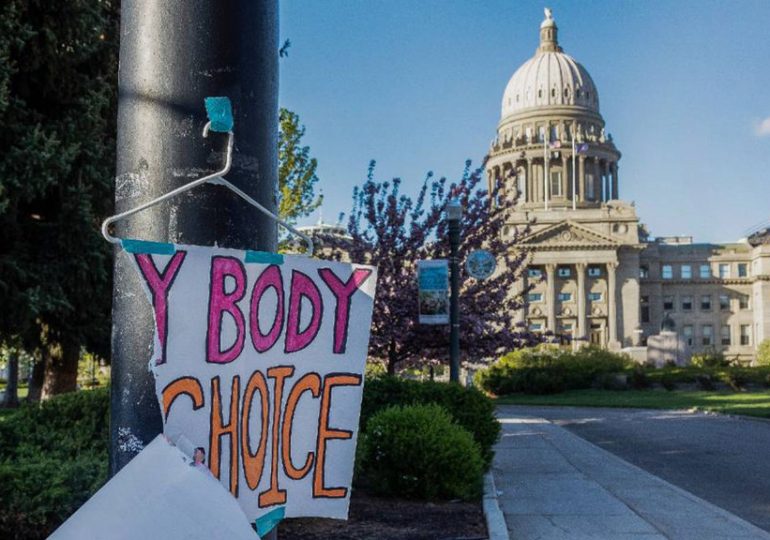The U.S. Supreme Court on Wednesday will hear a case on whether Idaho can enforce its near-total abortion ban in medical emergency situations under a federal law that requires most hospitals to treat patients with life-threatening conditions.
The case marks the second abortion-related challenge to come before the Justices this term, following the Court’s decision in Dobbs v. Jackson Women’s Health Organization in a 2022 ruling that left abortion policy to the states. Legal experts anticipate that the Court’s ruling in the Idaho case, called Moyle v. U.S., could establish a significant precedent regarding whether emergency medical care can be denied to a pregnant woman in distress in order to save the fetus.
[time-brightcove not-tgx=”true”]
At the heart of the case lies the clash between Idaho’s stringent abortion restrictions and the federal Emergency Medical Treatment and Labor Act (EMTALA), which mandates hospitals to stabilize patients facing life-threatening conditions regardless of their ability to pay. Idaho contends that EMTALA’s language requires equal treatment for both the pregnant patient and the “unborn child,” arguing that its near-total abortion ban does not conflict with federal legislation.
The Justices must decide whether they believe Idaho’s law conflicts with the federal EMTALA law. If they do, then the fundamental legal question they will have to consider is whether federal law supersedes state law when the two are in conflict, says Jill Habig, a former legal adviser to Vice President Kamala Harris in the California Attorney General’s office who now runs the Public Rights Project. While courts have consistently ruled in favor of federal law under the Supremacy Clause, the Idaho case attempts to challenge this bedrock principle. “What we’ve learned post-Dobbs, and especially with this right-wing court, is that things that should be simple legally are not actually simple in practice,” Habig says.
The legal battle in Idaho is part of a broader wave of challenges following the 2022 Dobbs decision that overturned Roe v. Wade, when a so-called “trigger” law automatically came into effect in Idaho prohibiting all abortions except in cases where it is deemed necessary to prevent the mother’s death. In legal filings, Idaho has noted that the term “abortion” is absent from the EMTALA statute enacted by Congress in 1986, arguing that abortion care was not intended as one of the required stabilizing treatments under the law. The statute does, however, include the phrase “unborn child,” which the state contends necessitates consideration of the fetus’s well-being when addressing medical emergencies.
Read More: How Kate Cox Became a Reluctant Face of the Abortion-Rights Movement
“Idaho law is perfectly consistent with EMTALA, which provides explicit protections for ‘unborn children’ in four separate places,” the state’s Republican Attorney General Raúl Labrador said in a statement. “The notion that EMTALA requires doctors to perform abortions is absurd.”
Lawyers for Idaho contend that the federal law only requires doctors to administer stabilizing treatments that are “available” at a particular hospital, and since abortion is largely prohibited under state law, it is effectively unavailable.
The Biden Administration sued Idaho over its abortion ban in 2022, resulting in a temporary injunction preventing its enforcement in emergency care situations, but the case has raised questions about the ongoing struggle between federal and state authority in shaping reproductive healthcare policy. Should the court side with Idaho’s interpretation, it would mark the first instance of a federal statute granting individual rights to a fetus and could pave the way for other Republican-led states to enact similar bans even in emergency situations.
Fourteen states have already banned abortion since the fall of Roe v. Wade, and while each of these bans include some kind of exception for the mother’s life, patients, doctors, and lawyers have run into challenges interpreting the statutes’ language. Many states permit abortions in a “medical emergency” but do not offer a concrete definition of that term, says Molly Duane, an attorney with the Center for Reproductive Rights. As a result, some women seeking abortions have been turned away from hospitals in life-threatening situations.
“What we know from the real experiences of patients and medical providers is that doctors are terrified to rely on these exceptions when years of prison time and loss of their medical license are on the line,” Duane says, adding that Idaho’s abortion law could enable state officials to challenge doctors on whether their patient is close enough to death to receive an abortion.
Read More: What Blocking Emergency Abortion Care in Idaho Means for Doctors Like Me
Several Idaho-based medical providers wrote in amicus briefs that the state’s abortion law does not match up with common medical judgment, forcing doctors to violate their oath and delay medical care until their patient’s condition deteriorates to the point that an abortion is necessary to save their lives. Some OB-GYNs have decided to leave Idaho over fear of being prosecuted for treating patients, according to the briefs. “There is no practice of OB-GYN in which abortion as a health saving life-saving measure can be taken out,” says Dr. Caitlin Gustafson, a family medicine obstetrician in Idaho and co-president of the Idaho Coalition for Safe Healthcare.
The outcome of the Supreme Court’s latest abortion-related case is poised to send a signal to states regarding their autonomy in shaping abortion policy. A ruling in favor of Idaho, legal experts say, could enable other states to pass strict abortion bans with fewer exceptions.
“We’ve seen across the country a race from anti-abortion states to pass more and more extreme bans,” Habig says, “and I think we can expect other states to follow Idaho’s lead if the Supreme Court allows Idaho to trump federal law and women’s health.”
Leave a comment







